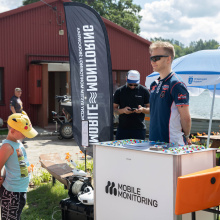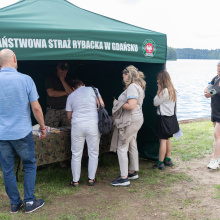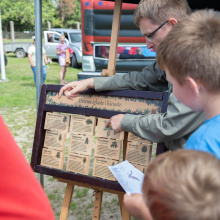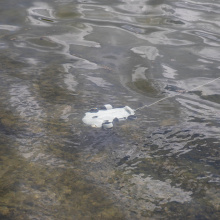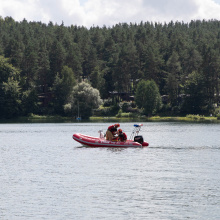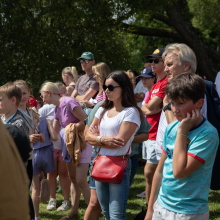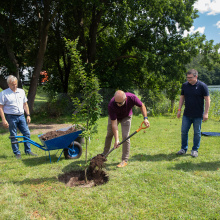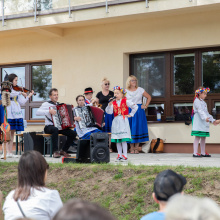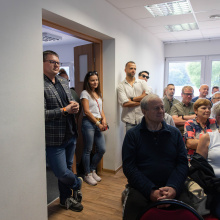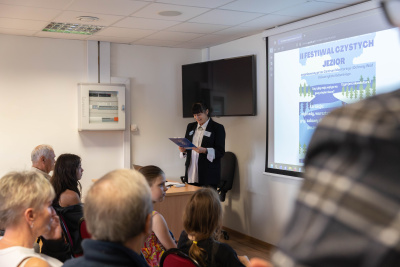
Scientific lectures, educational stands where visitors could learn about native and invasive species present in Kashubian lakes, a medical rescue demonstration, and a family field game were just some of the attractions prepared by the Centre for Monitoring and Protection of Waters in Borucino as part of the 2nd Clean Lakes Festival. This year's edition of the science picnic took place on July 30 (as usual at the CM&PW, picturesquely situated on the shores of Lake Raduńskie Górne). It was dedicated in a special way to climate change and its impact on lake ecosystems. A unique element of the 2nd Clean Lakes Festival was the planting of a tree commemorating the 55th anniversary of the University of Gdańsk.
‘I am very happy that we were able to meet at the second edition of the Clean Lakes Festival,’ said prof. dr hab. inż. Julita Dunalska, Head of the Centre for Monitoring and Protection of Waters at the University of Gdańsk. ‘This is a wonderful opportunity to share scientific knowledge about lakes and their protection with the local community, as well as with the many tourists who visit our region. Lakes are our common good and our shared responsibility. That is why I am particularly pleased to welcome volunteers from the Lake Guard, a citizen science programme in which citizens from outside the academic community work together with scientists to carry out professional monitoring of our lakes. I hope that all our guests, including the youngest ones, will have a great time and learn many important things about the lake ecosystem and how climate change affects it.’
To kick off the Festival, participants had the opportunity to listen to a popular science lecture by dr Janusz Filipiak from the Climate Research Laboratory at the University of Gdańsk entitled ‘Climate change in Poland - what do we know, where does our knowledge come from, where are we headed?’. Dr Filipiak gave the audience an insight into the particularly long history of meteorological observations in the Gdańsk area, dating back to the 18th century! He explained why it is so important to work with data series and how to interpret trends and anomalies that naturally occur in the life cycle of our planet in relation to meteorological observations and climate change.
‘Very high interannual variability in precipitation is an inherent feature of the precipitation regime. The systematic increase in annual maximum precipitation and the lengthening of periods between precipitation, understood as an increase in the tendency for areas to dry out, is a cause for concern. Combined with rising temperatures, which accelerate evaporation, all this increases the risk,’ explained dr Janusz Filipiak. ‘In the last 34 years, the temperature has risen by half a degree every 10 years. This rate is frightening because no natural ecosystem can cope with such a rate of increase. Some say that it was much warmer during the time of the dinosaurs. Sure, it was. But those temperature changes happened over a period of, say, 100,000 or a million years, and ecosystems had time to adapt accordingly. Climate change is like a speeding train. It cannot be stopped, but it can be mitigated.’
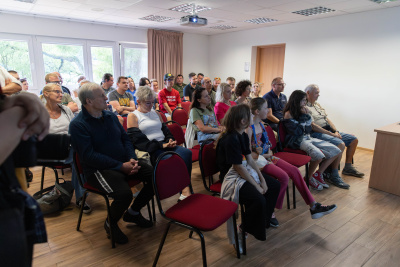
The second lecture was given by prof. dr hab. Konrad Ocalewicz from the Aquaculture Laboratory of the Faculty of Fisheries and Aquatic Sciences at the University of Gdańsk. It was devoted to fishing and aquaculture in the era of climate change, based on data on two fish species found in Polish lakes that are valuable in terms of fishing: vendace and common whitefish.
‘When we are too cold, we put on warm clothes, and when we are too hot, we turn on the air conditioning,’ said prof. K. Ocalewicz. ‘Fish are poikilothermic and can regulate their temperature in one way: they escape to a zone with the right temperature for their species, migrate, search. But what if this zone turns out to be an oxygen-depleted zone? The fish then has no chance to escape, reproduce or find food. This is a very complex mechanism, and removing or changing one brick causes all the other elements to become destabilised.’
The professor explained that one way to deal with climate change and its impact on biodiversity and the economic availability of various fish species is aquaculture: fish farming in pools with access to deep water, whose temperature can be adjusted to the needs of the species being farmed and, thanks to appropriate equipment, can also be oxygenated as needed. However, one of the challenges in applying this solution is the increase in energy prices that has been observed in recent years.
A tree for the 55th anniversary of the University of Gdańsk and a family field game
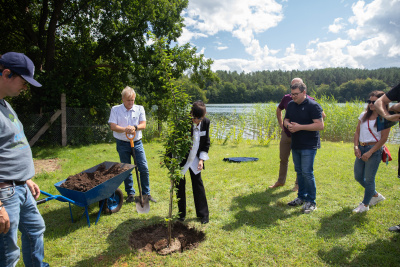
A unique element of this year's edition of the Festival was the ceremonial planting of a tree commemorating the 55th anniversary of the University of Gdańsk. A hornbeam was chosen, as it occurs naturally in this area and should therefore adapt well to its new location without posing a threat to the ecosystem.
Visitors were greeted by numerous educational stands prepared by CM&PW, employees and students of the Faculty of Oceanography and Geography of the University of Gdańsk, and exhibitors and partners of the Festival. To encourage visitors, especially children, who were present in large numbers at the event, to visit all the stands and learn as much as possible about the local ecosystem in a fun atmosphere, the organisers prepared a family field game. Participants collected stamps at individual stands by completing various knowledge and skill tasks and talking to stand supervisors about Kashubian nature and its protection. After collecting all 11 stamps, they could take part in a raffle for unique prizes.
Crayfish, fishes, and golden algae
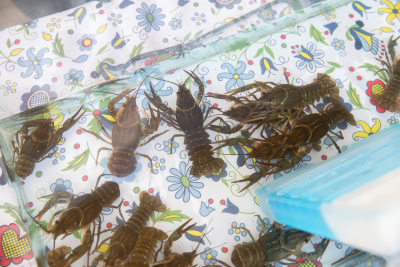
The stand where visitors could see live crayfish was very popular: one aquarium contained specimens of the mud crayfish, which is native to Polish lakes and an indicator of water purity, while the other contained American crayfish, an aggressive invasive species that found its way into lake waters from private farms as a result of irresponsibility and ignorance on the part of their keepers. The American crayfish is a species that is extremely resistant to environmental stress (including water pollution) and competes for habitat and food with the mud crayfish and the noble crayfish, increasingly displacing native crayfish species.
At a stand prepared by students and doctoral students from the Faculty of Oceanography and Geography of the University of Gdańsk, in cooperation with the Department of Marine Biology and Biotechnology of the University of Gdańsk, visitors could see live haptophytes of the species Prymnesium parvum, known as golden algae, which are being studied by prof. dr hab. Hanna Mazur-Marzec, under a microscope. Despite their beautiful colour, golden algae are very dangerous because they produce extremely potent ichthyotoxins called prymnezines. Under the neighbouring microscope, visitors could see phyto- and zooplankton, which form the basis of the food chain in the aquatic ecosystem, from a sample freshly taken from Lake Raduńskie Górne. The stand also featured an aquarium with live specimens of fish found in Polish lakes (such as roach, vendace and perch), which were provided by people associated with the Aquaculture Laboratory.
‘These are the most noble species, the most demanding in terms of environmental conditions, but also the most valuable economically,’ explains dr Marcin Kuciński from the Aquaculture Laboratory at the University of Gdańsk. ‘These rare specimens thrive in our breeding facility because the aquarium recreates the conditions of an oligotrophic lake, i.e. a lake with the highest water quality and species with the most demanding environmental requirements.’
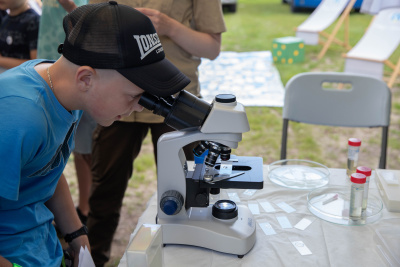
‘Under one of the microscopes, you can see Prymnesium parvum, known as golden algae, which is more widely known due to the so-called ecological disaster on the Oder River. As you can see, they are moving beautifully and quickly here. Fortunately, the sample does not come from nearby lakes,’ adds Karolina Pałucha, a doctoral student at the Doctoral School at the Faculty of Oceanography and Geography. ‘To prepare the sample visible under the second microscope, my colleague used a plankton net to catch “life’ from Lake Raduńskie Górne, which is right above us – here you can see what lives in our lake. How does this relate to fish? The golden algae visible under the first microscope produce toxins that are extremely harmful to fish, while the plankton that can be seen under the second microscope is food for fish.’
The State Fisheries Guard, which is responsible for enforcing the law in inland fisheries and combating poaching, has prepared information leaflets on the fish species found in the surrounding waters and the regulations governing their catch. At the Guard's stand, visitors could also play a special type of memory game to help them learn to recognise fish.
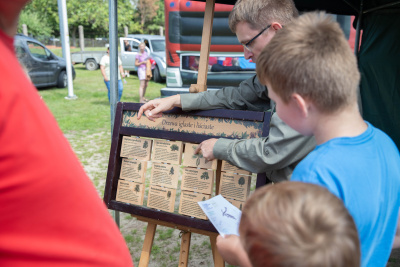
At the stand of the Kartuzy Forest District, visitors could learn to recognise tree species characteristic of the lake district, as well as the paw prints of animals found in the surrounding forests. PM Ecology, a company that supplies rainfall data collection devices to many cities in Poland, including the Tri-City, shared its knowledge on automatic environmental data collection and the devices and systems used for this purpose. Mobile Monitoring, a company creating innovative solutions in the field of environmental monitoring and water safety, presented aerial drones and talked about their use in observing anthropogenic pressure in the coastal zone of lakes. Guests also had the opportunity to take part in a water rescue demonstration entitled ‘Safety on the Water’, prepared by the Volunteer Fire Brigade in Sulęczyno. Firefighters shared their knowledge on how to safely enjoy time spent by the water and how to provide first aid to a person who has had an accident in the water.
Lake Guard - a citizen science initiative
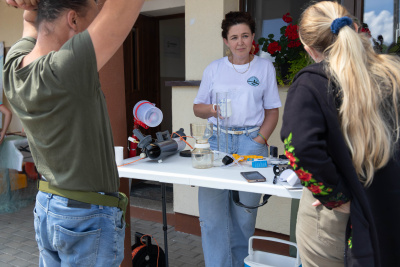
Volunteers from the Lakes Volunteer Programme - Lake Guard, who are involved in citizen monitoring of lakes, also talked about their activities. The programme involves citizens in collecting water samples from selected water bodies. After completing training, volunteers collect water samples, which are then analysed in the CM&PW laboratory, and carry out a general inspection of water quality and transparency. They are also involved in educational activities on the protection of water ecosystems in their local community.
‘I got involved in this project after hearing an announcement on Radio Gdańsk,’ said one of the volunteers. ‘I was interested because I live by a lake that I thought was heavily polluted, which turned out to be true. I wanted to know the real situation: whether it was just “biologically rich’, as some people claimed, or actually polluted. The fate of lakes is important to me, it is our common civic responsibility, we all have to start taking care of our waters. So I signed up, received an invitation, took a preparatory course for volunteers with my friends, and took on this task – and here we are. Simply to raise awareness and share the knowledge we gained from Professor Dunalna. I would like to add that before joining the programme, I had no specific knowledge, I did not know how to take samples, I have no relevant education, and I work in a completely different field – but this was not an obstacle, because the preparatory course equipped us with the necessary knowledge and skills. We invite everyone interested to join the next edition of the programme, no special preparation is required!’
However, the volunteers pointed out that water samples are taken from the pelagic zone, so you need to be prepared to go out to deeper parts of the lake (e.g. by kayak, boat, or pedal boat). They emphasised the need to raise environmental awareness and sensitise the public to the anthropogenic degradation of lakes, which has been accelerating in recent years, partly due to growing prosperity and increased tourist traffic in areas that until recently were quite isolated.
For the soul and the palate
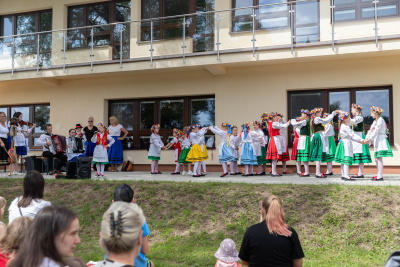
Artistic impressions were provided by the Kashubian Children's Ensemble ‘Motylki’/Mòtilczi, who performed in beautiful regional costumes and presented elements of the rich Kashubian culture.
The Centre for Monitoring and Protection of Waters is a research and teaching unit of the University of Gdańsk, but it also wants to be part of the local Kashubian community, which is why the Festival could not be without elements related to Kashubian tradition.
The taste buds of the participants were taken care of by the Association of Exceptional Housewives in Borucino, who served a real feast of local delicacies. The hostesses were assisted in feeding the guests by the State Fisheries Guard, which prepared a huge zander, and the 'Kaszub' Fishing Club in Somonino, which served chanterelle soup. There were also grilled sausages, courtesy of the event hosts.
The next Clean Lakes Festival will take place next year – we invite you to join us! We also encourage you to follow the website and Facebook page of the UG Centre for Monitoring and Protection of Waters, where the latest information on its extensive activities is published.
All exhibitors:
- Kashubian Landscape Park
- Wdzydze Landscape Park
- Słowiński National Park
- Kartuzy Forest District
- District Headquarters of the State Fire Service (PSP) in Kościerzyna
- Volunteer Fire Brigade in Sulęczyno
- State Fisheries Guard in Gdańsk
- Kaszub Sport Fishing Club - Somonino
- Local Fishing Group - Kaszuby ‘Chmielno’
- Radbur Sp. z o.o.
- Children's Group ‘Motylki’
- Association of Exceptional Housewives in Borucin
- Kashubian Handicrafts “Farwa’
- Mobile Monitoring
- PM Ecology
- Voluntary water monitoring ‘Straż Jeziora’
- Faculty of Oceanography and Geography, University of Gdańsk, Department of Marine Biology and Biotechnology, Aquaculture Laboratory


